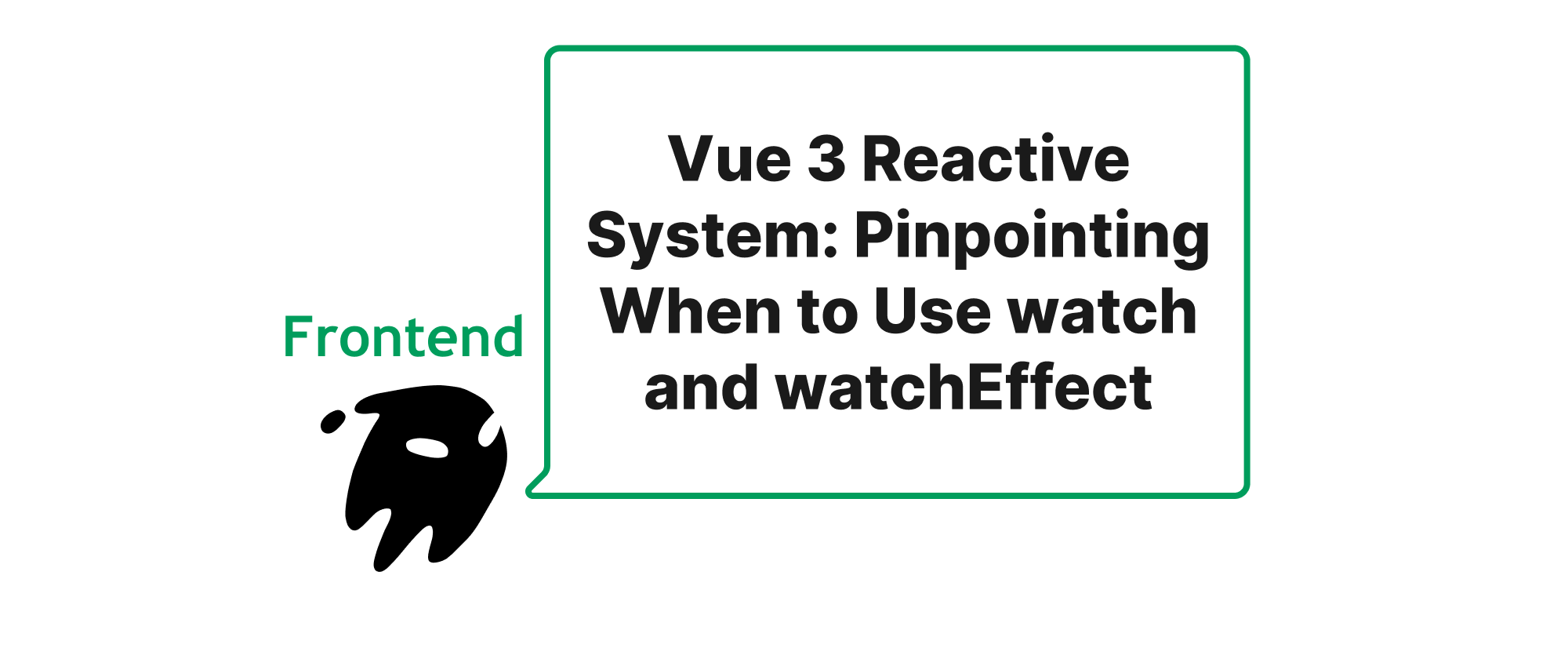Vue 3 Reactive System: Pinpointing When to Use watch and watchEffect
James Reed
Infrastructure Engineer · Leapcell

Introduction
In the vibrant landscape of frontend development, Vue.js continues to be a dominant force, and its reactive system is a cornerstone of its appeal. As developers, we constantly strive for efficient, maintainable, and performant applications. A key aspect of achieving this in Vue 3 revolves around effectively managing reactivity, particularly when it comes to reacting to data changes. Vue 3 offers two powerful tools for this purpose: watch and watchEffect. While both allow us to perform side effects in response to reactive state changes, their nuances and appropriate use cases can sometimes be a source of confusion. Understanding their precise applications isn't just an academic exercise; it directly translates to writing cleaner, more optimized, and less error-prone Vue applications. This exploration aims to clarify these distinctions, empowering you to make informed decisions about which watcher to deploy for your specific reactive needs.
Understanding Vue 3's Reactive Watchers
Before diving into the specifics of watch and watchEffect, let's briefly touch upon the core concepts that underpin them within Vue 3's reactivity system.
Reactivity: At its heart, reactivity in Vue means that when data changes, parts of your application that depend on that data automatically update. This is achieved through a proxy-based system that traps property access and modification.
Side Effects: In the context of watchers, a side effect is any operation that occurs as a direct result of a reactive dependency changing. This could be anything from logging to the console, making an API call, updating the DOM directly, or modifying other reactive state.
Now, let's look at our two key players:
watch
The watch function is a more explicit and configurable way to react to changes in specific reactive data sources. It requires you to explicitly specify what you want to watch.
Principle: watch takes a source (or an array of sources) and a callback function. The callback function is executed whenever the source's value changes. It also provides access to both the new and old values of the watched source.
Implementation Example:
import { ref, watch } from 'vue'; export default { setup() { const count = ref(0); const searchKeyword = ref(''); // Watching a single ref watch(count, (newCount, oldCount) => { console.log(`Count changed from ${oldCount} to ${newCount}`); // Perform side effect, e.g., make an API call // if (newCount > 5) { // console.log('Count is getting high!'); // } }); // Watching multiple sources (array of refs) watch([count, searchKeyword], ([newCount, newKeyword], [oldCount, oldKeyword]) => { console.log(`Count changed from ${oldCount} to ${newCount}`); console.log(`Keyword changed from '${oldKeyword}' to '${newKeyword}'`); // Update some derived data or trigger complex logic }); // Deep watching objects (explicitly enabled) const user = ref({ name: 'Alice', age: 30 }); watch(user, (newUser, oldUser) => { console.log('User object changed:', newUser); }, { deep: true }); // Immediate execution (callback runs immediately on component setup, then on changes) watch(count, (newCount) => { console.log(`Initial count or count changed: ${newCount}`); }, { immediate: true }); const increment = () => { count.value++; }; const updateKeyword = (event) => { searchKeyword.value = event.target.value; }; const changeUserName = () => { user.value.name = 'Bob'; // This will trigger the deep watch }; return { count, searchKeyword, user, increment, updateKeyword, changeUserName }; } };
Application Scenarios for watch:
- Reacting to specific data changes with old and new values: When you need to compare the previous state with the current state (e.g., to determine if a value increased or decreased, or for logging purposes).
- Performing expensive operations only when necessary: If you have a complex computation or an API call that should only trigger when a very specific piece of data changes,
watchallows you to pinpoint that dependency. - Watching multiple independent sources: You can observe several reactive properties simultaneously and react when any of them change, which is useful for cross-dependency logic.
- Deep watching nested objects: By explicitly setting
deep: true,watchcan detect changes within nested properties of an object, which is not automatic forwatchEffect(unless the inner property is accessed directly withinwatchEffect). - Controlling when a watcher runs (e.g.,
immediateoption): When you need the side effect to run once immediately upon component mounting, in addition to running on subsequent changes.
watchEffect
The watchEffect function is a simpler, more automatic way to react to changes. It doesn't require you to specify the dependencies upfront. Instead, it automatically tracks the reactive dependencies accessed during its initial run.
Principle: watchEffect immediately executes the given function, and a reactivity system automatically tracks any reactive properties accessed during that execution. Whenever any of those tracked dependencies change, the function is re-run.
Implementation Example:
import { ref, watchEffect } from 'vue'; export default { setup() { const firstName = ref('John'); const lastName = ref('Doe'); const age = ref(30); // WatchEffect reacting to firstName and lastName watchEffect(() => { console.log(`Full Name: ${firstName.value} ${lastName.value}`); // This watchEffect will re-run whenever firstName or lastName changes. // It does NOT track 'age' because 'age' is not accessed within the callback. }); // WatchEffect with a cleanup function let timer; watchEffect((onCleanup) => { console.log(`Current age: ${age.value}`); // Simulate an asynchronous operation timer = setTimeout(() => { console.log(`Age updated to ${age.value} after delay`); }, 1000); onCleanup(() => { // This function runs before the effect re-runs or when the component unmounts console.log('Cleaning up previous age effect...'); clearTimeout(timer); }); }); const updateName = () => { firstName.value = 'Jane'; lastName.value = 'Smith'; }; const increaseAge = () => { age.value++; }; return { firstName, lastName, age, updateName, increaseAge }; } };
Application Scenarios for watchEffect:
- Automatic dependency tracking: When you want a side effect to run whenever any reactive dependency accessed within its callback changes, without manually listing them. This often leads to more concise code.
- Performing side effects where old values are not needed: If you only care about the current state to perform an action (e.g., updating a derived ref, making an API call with current data, or logging).
- Simplifying data synchronization: When you have a piece of derived state or an external effect that needs to stay in sync with multiple internal reactive sources.
- When the side effect is the computation: For example, setting up a subscription or a resource that needs to be torn down when dependencies change (using the
onCleanupcallback).
Key Differences and When to Choose Which
| Feature | watch | watchEffect |
|---|---|---|
| Dependencies | Explicitly declared as the first argument (e.g., ref, computed, getter function, array of sources). | Automatically inferred from the synchronous code executed within its callback function. |
| Callback Arguments | Receives (newValue, oldValue, onCleanup) or ([newVals], [oldVals], onCleanup) for multiple sources. | Receives (onCleanup) only. Does not get newValue or oldValue. |
| Initial Execution | Not by default. Requires { immediate: true } option to run on component setup. | Always runs immediately on component setup to collect initial dependencies. |
| Deep Watching | Requires { deep: true } option for objects. | Tracks property access. If obj.prop is accessed, it tracks obj.prop. If only obj is accessed, it does not track inner changes unless obj.value is assigned a new object. |
| Use Case | When you need to react to specific dependencies, access old values, or control execution more precisely. | When you want an effect to automatically re-run whenever any of its accessed reactive dependencies change, for simpler sync logic. |
| Simplicity | More explicit and configurable. | Simpler and more automatic for simple side effects. |
The precise use case boils down to:
- Choose
watchwhen you need to know the previous value of a specific data source, or when you only want to react to certain, explicitly defined changes. This provides fine-grained control and is essential for conditional logic based on value changes. - Choose
watchEffectwhen you simply want to re-run a block of code whenever any reactive state accessed within that block changes, and the exact previous value isn't relevant. This is ideal for synchronizing external state or performing side effects that depend on the current state of multiple reactive dependencies.
Conclusion
Vue 3's watch and watchEffect are both indispensable tools in a developer's arsenal for managing reactivity. While watch offers explicit control, allowing you to define precise dependencies and access historical values, watchEffect provides an elegant, dependency-free approach that automatically reacts to any accessed reactive state. By understanding their distinct mechanisms and use cases, you can write more efficient, maintainable, and declarative Vue applications. Ultimately, watch is for explicitly reacting to specific, tracked changes for control, while watchEffect is for implicitly reacting to all accessed dependencies for simplicity.


